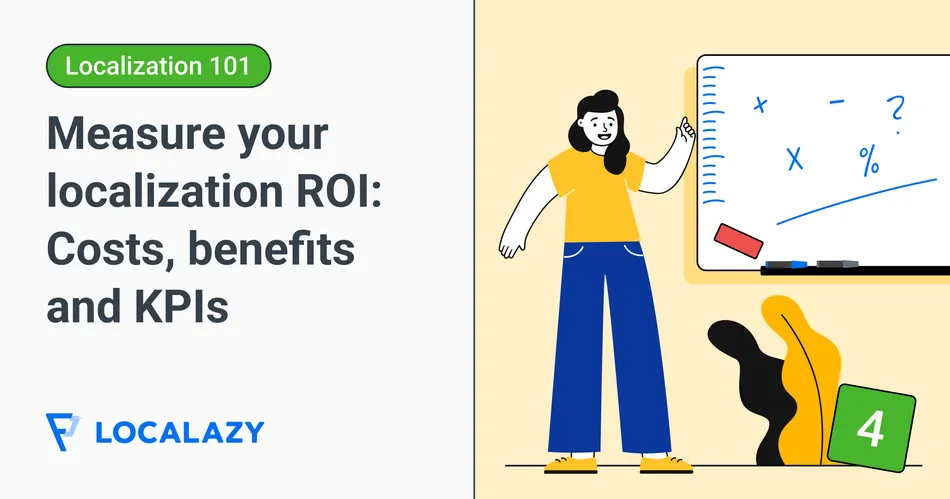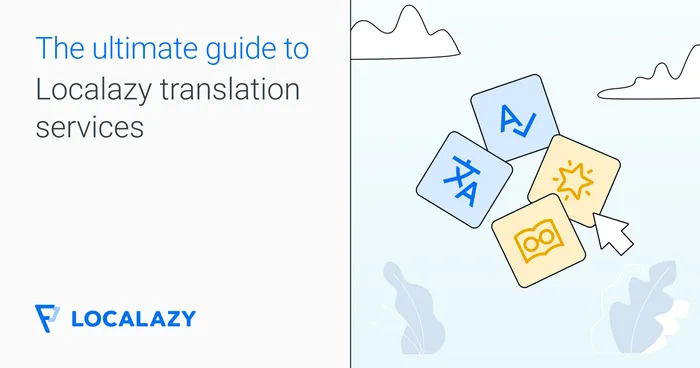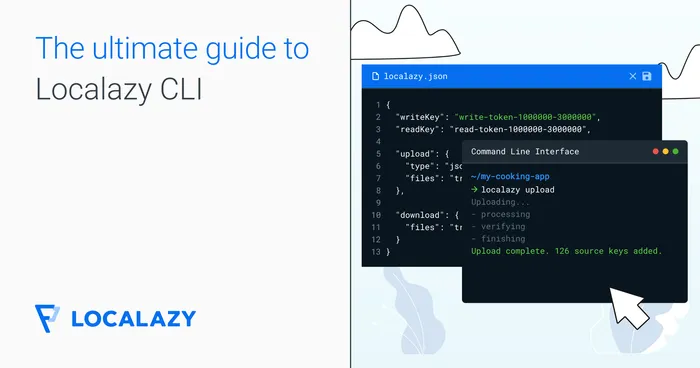Businesses localize their software to make more money and spend less. Oversimplified? Yes, but I put it this way on purpose — to let us focus on a particular aspect of localization: investment.
Before we invest in something, we want to estimate the potential gain, a.k.a. Return On Investment (ROI). This is the difference between what we paid for localization and how our net profit changed as a result.
The simplest localization ROI formula looks like this:
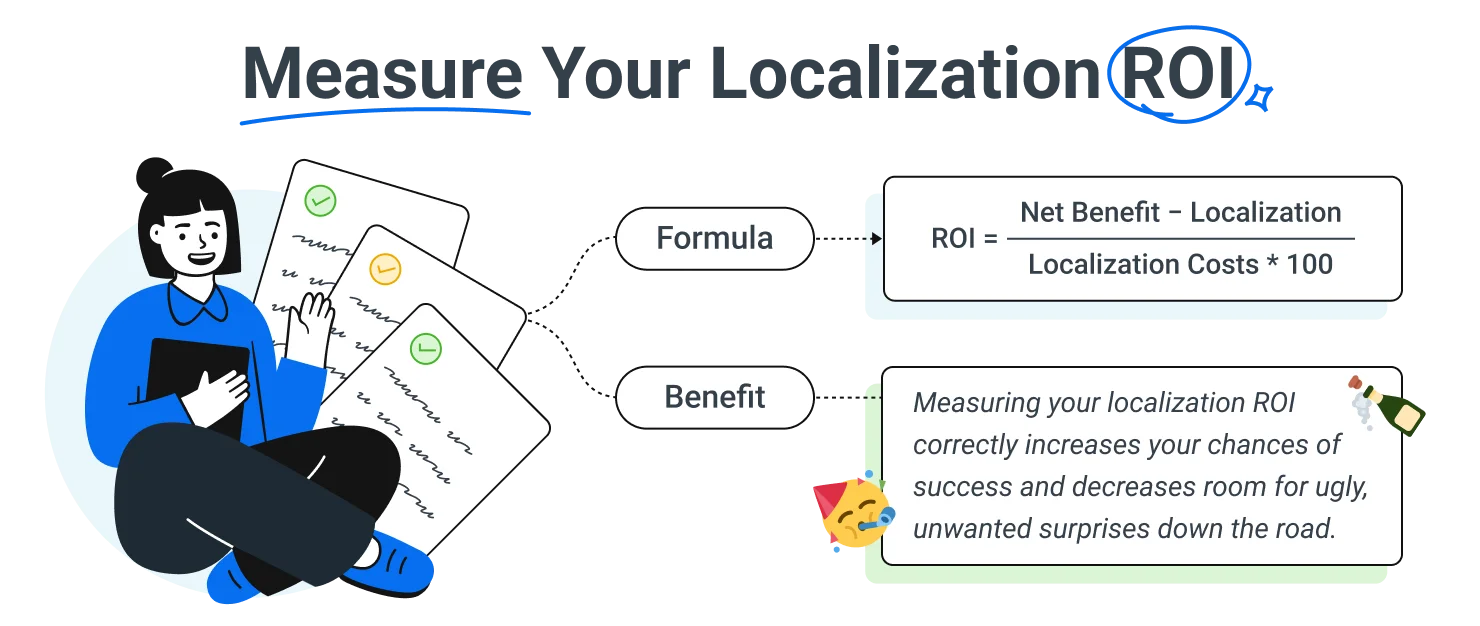
Here’s an example: you get your app translated into German for $5,000. Then your users pay $15,000 within the German interface. In this case, your net profit will be $10,000, which is twice what you paid, or 200%.
However, adding time into the mix complicates calculations. The “then” in the above formula stands for days, weeks, months, or years needed to hit the projected metrics. So, you will have to set milestones and track your actual ROI against them. Things get even more complicated when we consider all the unknowns and variables. As Nikola Kozuljevic, CMO at Smartsupp, confirms:
“It's extremely challenging to attribute business metrics like MRR or churn to localization. Transactions, in our case purchases of subscriptions, are hardly attributed to it [...]. It's also tough to A/B test — we don't know how many people do not buy our solution because of a lack of localization, which we don't see”
Due to the challenges in measuring localization ROI, we cannot create a formula for every situation. But considering all the possible variables and unknowns will help us put together a framework for tracking and measuring net revenue independently.
In this article, I’m inviting you to brainstorm such a framework together. To make the most of it, I spoke with my copywriting clients and Localazy’s experts and clients. Let’s see what we’ve got.
💸 The INvestment: What goes in (localization costs) 🔗
Localization costs are usually easier to grasp than its benefits.
But, what are you exactly investing in? The Cambridge Dictionary defines localization as "the process of making a product or service more suitable for a particular country, area, etc." However, you can’t just make your product “more suitable for a particular demographic” and hope these users will come. Even a restaurant in a busy tourist area uses outdoor advertising to boast about the languages of its menus. And you will likely need to invest in additional advertising, too.
Speaking of restaurants, they don’t just localize their menus. They also hire waiters who speak at least some of their menu languages. So, depending on the nature of your business, you might or might not need to recruit customer support for the new languages.
A restaurant like that has an advantage: customers come to its country, not the other way around. But if you expand to new markets, you just don’t need to localize your product — you will also have to comply with new regulations. See how the expenses stack up?
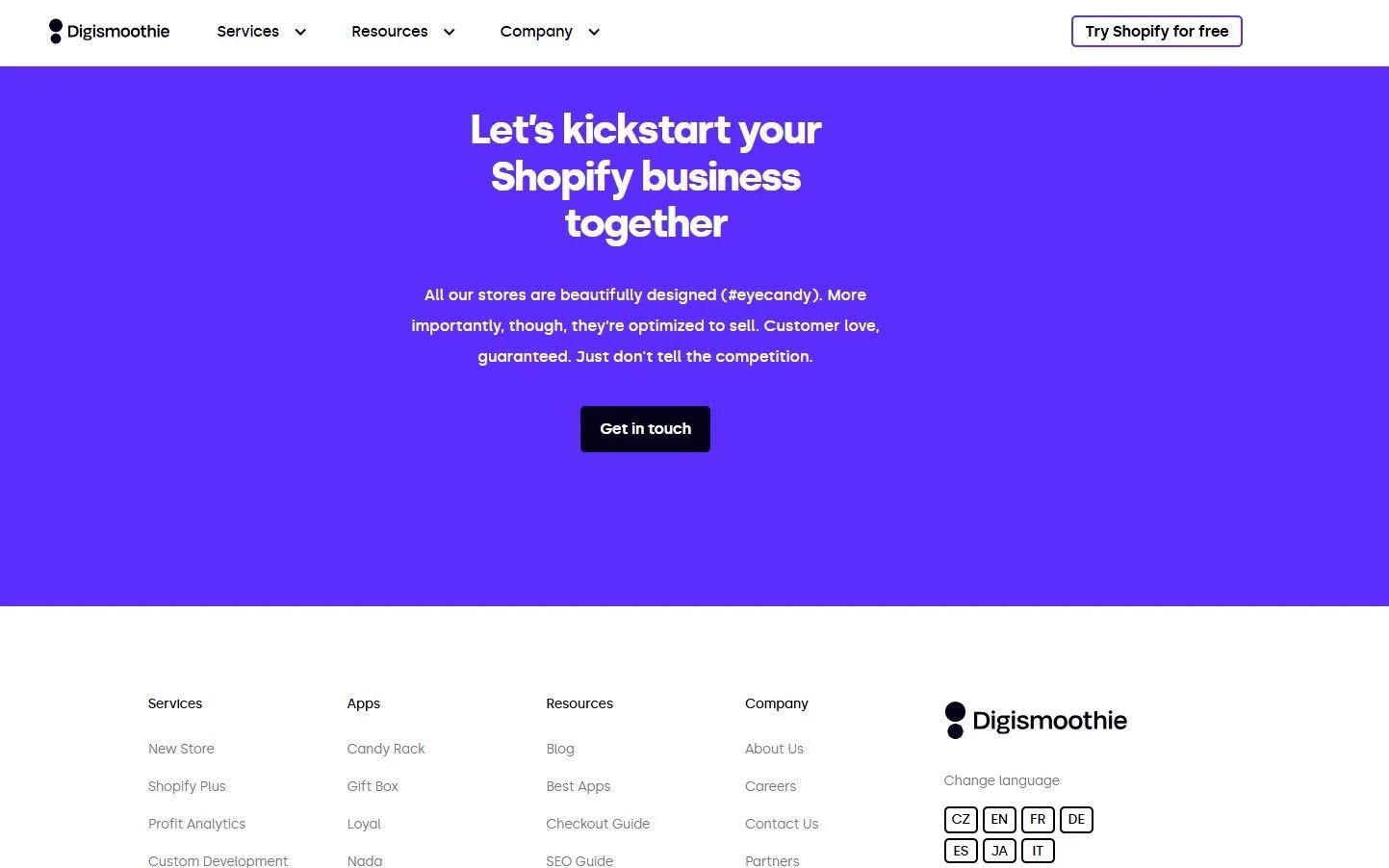
Tomas Janu is the co-founder of Digismoothie, a Shopify development company that uses Localazy to localize their content to six languages. Here’s what he shared about their localization costs:
"We paid for localization and a higher Webflow plan. We need more time to maintain the site and keep all locales up-to-date (i.e., when you change something in English, you need to change it in the new locales)"
As you plan to reach out to new demographics, take time to brainstorm all the associated costs. I’ve made this table to give you a starting point. Some costs can be calculated upfront (marked with ✓), while others require research and estimation (marked with 🔍). A few costs might only become clear once you start the project (marked with ⚠️).
💶 If you want to learn more about localization-specific costs, check out this article on budget allocation
💰 The revenue: What comes back (localization benefits) 🔗
A restaurant is not an online socks store. They don’t just sell different things — they use different metrics to track their success. The same should apply to localization ROI measurement.
Some businesses focus purely on fiscal metrics such as revenue, costs, and profit margins. Others, like non-profits, measure their impact through non-monetary indicators such as the number of people reached and engaged. Most organizations track both types of benefits, though they may prioritize one over the other.
Here’s how Tomas’s team at Digismoothie measured their localization results:
“Benefits were approximately 25% increase in organic traffic, which we monetize via app installations and Shopify referrals”
In the table below, I've marked each metric with ✓ if it's easy to track directly, 🔍 if it requires some analysis but is measurable with proper systems, and ⚠️ if it's complex to track and requires multiple data points and interpretation.
Of course, this list isn’t exhaustive or universally applicable. I’m not an expert in every area, but it will give you a good start in understanding localization ROI.
Let’s see how this plays out in real life across four business scenarios.
Scenario 1: A B2B website 🔗
🏢 What does a manufacturer of drywall systems, insulating panels, and concrete paving need a website for?
You don’t buy such products in two clicks. This segment relies on direct B2B contacts, loan applications, and tenders. So, we are dealing with a long decision-making journey whose different stages are represented by different people.
Let’s say an international real estate development company applies for a loan. A Swiss-French bank clerk checks the developer’s suppliers, which leads her to the manufacturer’s website. If it strikes a chord with her, the clerk will move the application to the next stage.
What can the manufacturer do to boost its chances? Localize its website in French.
In his book “Pre-Suasion,” Professor Robert Cialdini refers to the Taliban releasing South Korean hostages as soon as a Pushtun-speaking negotiator was provided. According to the author, the persuasive power of feelings like affinity, unity, and liking runs so deep in us, even cold-blooded terrorists aren’t immune. And the native language is at the core of it.
Besides, this manufacturer’s competitors could feature 100% identical content on their websites, but none in French. The clerk will likely favor the one that offers content in their mother tongue. Irrational? Yes, but so what? Dan Kennedy, a copywriter and business consultant, claims “trust is irrational” and “people trust for all the wrong reasons.”
Scenario 2: A not-for-profit platform 🔗
🤝 If your investor is the US government, your localization success might be defined by units other than Franklins and Jacksons.
The San Francisco Bay Area is home to many Latin American immigrants still learning English and looking for a job. A local government-funded organization helping jobseekers develop their professional skills promotes its initiatives in English and Spanish.
The organization has an informational website with a member platform that helps match job seekers with employers. But it’s all in English, so localizing these resources in Spanish would be a natural next step.
Scenario 3: A B2C service platform 🔗
⚖️ An Austrian startup offers a platform where people and businesses can get their legal documents checked by experts.
The current platform supports one language and matches clients with lawyers in Austria. But many immigrants don’t know German well enough to understand the intricacies of local laws. And wouldn’t we all benefit from a similar service, wherever we live and whatever our mother tongue?
The startup has two directions to expand through languages: inwards and outwards. Let’s consider the former scenario first.
When you use a service in a familiar language, things are easier and faster, which makes you happy. You might then refer others and accept potential price hikes. You will also make fewer mistakes and require less support, which saves the company support costs. A whole pack of benefits!
Lawyers will also appreciate having more clients through fast and easy service. This will save you recruitment and onboarding costs.
The advertising budget will change over time as early efforts generate word of mouth. As a migrant myself, I can assure you it spreads fast. We won’t be able to precisely measure the impact of advertising later, as you can’t isolate it from word of mouth.
Scenario 4: An entertainment app 🔗
📱 With mobile apps, we can track localization effects across transparent monetization metrics.
Let’s say we have a crypto trading simulator app with an English interface. We make money through in-app ads and paid gamification features.
There are also hidden costs like currency conversion fees, tier upgrades, and QA testing for each language.
🛠️ Where to start: Minimal Viable Localization (MVL) 🔗
To decide whether to localize or not, we need to make a forecast. I spent countless hours creating a comprehensive cheatsheet for quantifying the ROI of localization projects, but ended up with something else.
Demographic expansion is like a startup. With so many unknowns, why not use the Lean approach?
We can create a Minimal Viable Localization (MVL) strategy (just enough translation to let new demographics get a grasp of the product) and run a three-month proof of concept (POC) to test its potential. Based on these results, we will decide whether to invest in full demographic expansion. 🕵
As you follow me along, try to consider how you can adjust this framework for your business and target demographic.
1. Calculate the full expansion cost 🔗
We can start by calculating how much it would cost us to go all-in first to target a particular demographic. This includes:
🧾 One-time investments
- Translation of all content
- Technical implementation
- Analytics setup for a new language
- Initial QA (testing)
- Minimal legal / compliance costs
📊 Costs based on historic data
- Advertising and marketing spend per language to get traction
- Customer support capacity
- Operations staff, if needed
💡 Potential cost reductions
- Support efficiency through better understanding
- Marketing efficiency through word-of-mouth
- Shared technical infrastructure
After quantifying the total cost, you might find out you can afford complete localization without breaking the piggy bank. Otherwise, proceed to the next step.
🗓️ Struggling to make sense of these numbers? Book a free consultation with a localization expert
2. Calculate test investment 🔗
🎯 Using early KPIs
* CPA stands for cost per acquisition, or how much it costs you to acquire a new user or customer. In this context, I suggest forecasting based on the CPA recorded during your first successful marketing and advertising campaign in the current language.
Example: $1 per user × 1,000 users = $1,000 test advertising & marketing budget
🔤 Minimal Viable Localization (MVL)
- Homepage (consider adding important details from other pages)
- Contact / inquiry forms
- Essential UI elements (navigation menu items, buttons, error messages, success confirmation, etc.)
🧭 Monitoring setup
- Language-specific analytics (e.g., engagement within a particular language interface)
- Conversion tracking
- Support ticket tracking
3. Three-month test structure 🔗
Once this is done, a simple way to test the ROI of localization is to run a three-month experiment that gradually reduces marketing spend. This structure shows whether your product can sustain growth once the initial push is over.
| Month | Actions | Budget | Key metrics to track |
|---|---|---|---|
| 1 | Deploy your MVL | 100% of test marketing budget |
• Actual cost per acquisition • Conversion rates • Support needs |
| 2 | Continue test phase | 50% of test marketing budget |
• Organic growth • Word-of-mouth effects • Support ticket trends |
| 3 | Observation only (no paid marketing) | 0% (no spend) |
• Sustained engagement • Organic growth rate • Support needs' stabilization |
4. Create a forecast 🔗
Now we can project:
- Time to cover one-time costs = One-time costs ÷ Monthly net profit.
- Monthly net profit, which can be calculated using these formulas:
Example:
- One-time costs: $10,000.
- Actual CPA: $50.
- Word-of-mouth factor: Each paid customer brings 0.2 additional customers.
- Revenue per customer: $200.
- Other monthly expenses (e.g., support, operations): $1,000.
- Monthly marketing: $2,000.
- Paid customers = Monthly marketing spend ÷ CPA = $2,000 ÷ $50 = 40.
- Word-of-mouth customers = Paid customers × Word-of-mouth factor = 40 × 0.2 = 8.
- Total customers = Paid customers + Word-of-mouth customers = 40 + 8 = 48.
- Monthly revenue = Total customers × Revenue per customer = 48 × $200 = $9,600.
- Monthly costs = Monthly marketing spend + Other monthly expenses = $2,000 + $1,000 = $3,000.
- Monthly net profit = Monthly revenue - Monthly costs = $9,600 - $3,000 = $6,600.
- Time to cover one-time costs = One-time costs ÷ Monthly net profit = $10,000 ÷ $6,600 ≈ 1.52 months.
- Monthly marketing spend: $4,000.
- Paid customers = $4,000 ÷ $50 = 80.
- Word-of-mouth customers = 80 × 0.2 = 16.
- Total customers = 80 + 16 = 96 customers.
- Monthly revenue = 96 × $200 = $19,200.
- Monthly costs = $4,000 (marketing) + $1,000 (other expenses) = $5,000.
- Monthly net profit = $19,200 - $5,000 = $14,200.
- Time to cover one-time costs = $10,000 ÷ $14,200 ≈ 0.70 months.
- Seasonal variations (if test period different from original growth phase)
- Market-specific events
- Competition in a new language market
- Infrastructure sharing benefits
- Culture-related localization ROI challenges
➡️ Yes: localization culture plays a role in costs, too. Some tips to enhance it here
5. Decision framework 🔗
Scale your localization if test results show:
👀 Market shows viability
- Actual CPA ≤ 120% of original growth-phase CPA.
- Conversion rate ≥ 80% of original growth-phase rate.
💹 You can achieve the desired ROI period through available marketing spend scenarios
Conservative forecast (lower monthly spend):
- Longer time to ROI but lower risk.
- Must still hit ROI ≤ 12 months.
Aggressive forecast (higher monthly spend):
- Faster time to ROI but requires more resources.
- You must have enough budget.
🧑💻 Support costs align with expectations (due to shared infrastructure)
This framework acknowledges that you partially control the ROI period through marketing spend decisions, rather than treating it as a fixed threshold.
🎙️ How accurate are localization metrics? Listen to our discussion with Kevin O’Donnell on the topic here
6. Scaling plan 🔗
If the test is successful:
🟡 Months 4-5: Complete localization
- Translate remaining content
- Implement full technical requirements
- Set up comprehensive analytics
- Extend support infrastructure
🔵 Month 6: Full launch
- Deploy complete language version
- Choose and implement the selected marketing spend forecast (conservative or aggressive)
- Start collecting comprehensive metrics
🟠 Months 7-9: Monitor and optimize
- Track actual ROI against projected forecast
- Control costs and readjust marketing spend if needed
- Monitor support needs
- Document learnings for future language launches
- Learn about strategies for maximizing your localization ROI
🟢 Month 10+: Consider the next language based on...
- Actual vs. projected ROI in first language
- Marketing spend efficiency
- Resource utilization
- Next market opportunity size
🔄 Continuous localization ROI analysis 🔗
You won’t be able to separate some of the localization effects from unrelated ones. For instance, you may be improving your customer support technology at the same time, and both these initiatives will help cut support tickets.
With so many unknowns and variables, is it even possible to track the ROI of localization continuously?
Let’s try the following framework based on Tables 1 and 2:
Start with what you can track 🔗
Focus first on the ✓ metrics below for immediate, reliable feedback. These are your early warning system for what's working or not.
Chain localization metrics 🔗
Link easy-to-track localization metrics with harder ones to understand broader patterns. Here are some examples to get you started:
🧵 Support chain
📈 Engagement chain
💵 Revenue chain
👥 User growth chain
📚 Content chain
Use time windows 🔗
- Daily/Weekly: Direct metrics (✓)
- Monthly: Analysis-required metrics (🔍)
- Quarterly: Complex metrics (⚠️)
Context matters 🔗
When reviewing metrics, always ask:
- What else changed during this period?
- Are there seasonal factors?
- Did competitors make moves?
- Were there market-wide trends?
- What unexpected localization challenges emerged?
Trust patterns, not points 🔗
Don't overreact to single measurements. Look for:
- Consistent trends over time
- Correlations between metrics
- Repeatable patterns
- Seasonal variations
🧭 Conclusion 🔗
This is a long article — I get it. But I hope the hours I invested in research, modeling, calculating, and communicating with different people have been hours well spent. I hope you are now more enlightened about the ROI of localization than before reading it.
If you are more puzzled, I get it, too. The perspective I presented here might not be easily applicable to your situation. You might also be unsure about what languages to tackle first before you track their business impact. In that case, head over to this guide for advice.
Anyway, if you need help figuring it out, start by using Localazy as your TMS solution before tackling other steps or consulting Localazy’s experts. They won't spill the secrets of their clients over the past six years or do all the calculations for you. But you will get more reliable figures than you can ever guess, and learn how to optimize your localization efforts to maximize ROI.
